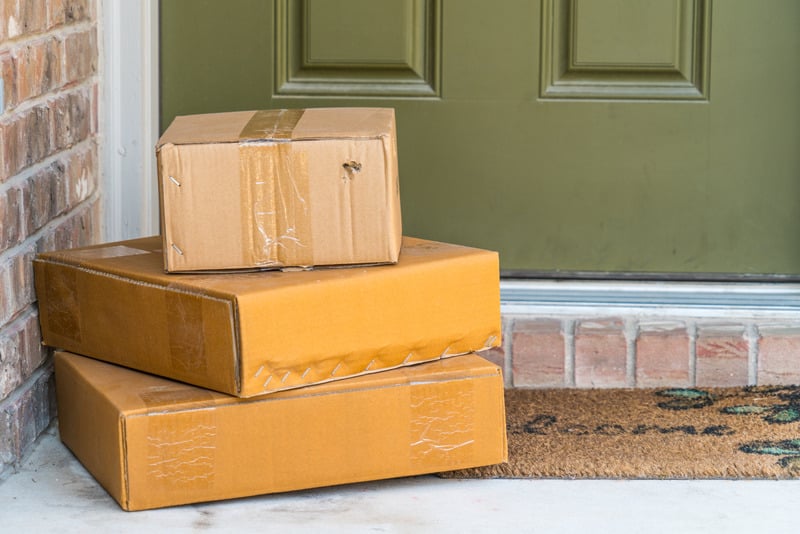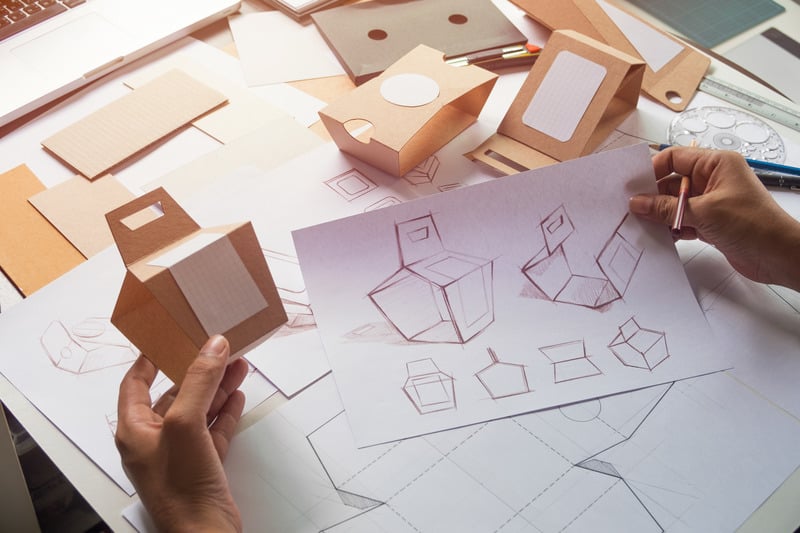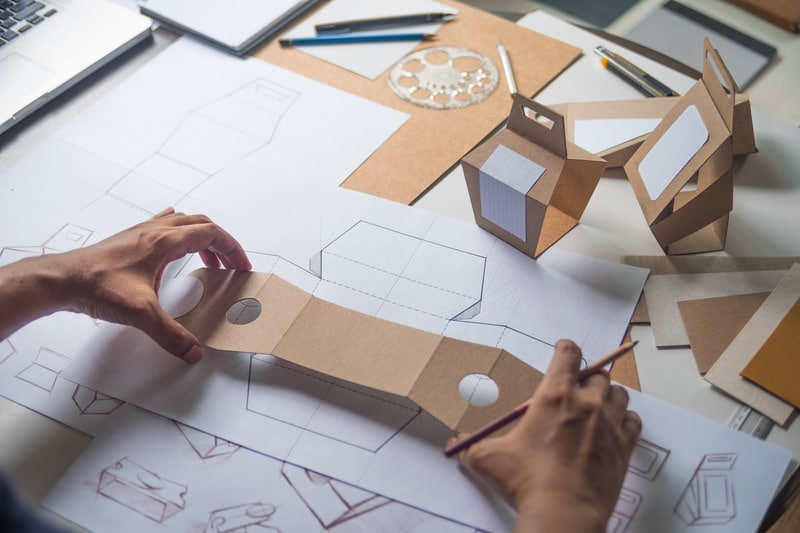Creating packaging design ideas is a fine art. It goes beyond attention-grabbing style, memorable branding and protecting your product. Packaging needs to meet a range of different objectives in order to be visually appealing and practical to manufacture. This demands a carefully considered, well-rounded approach.
Striking the right balance between aesthetics and functionality can be complex. It requires good knowledge of your target market, manufacturing principles and the competitive landscape. It’s important to get it right, as packaging plays a huge role in the success of your product. This is why it’s helpful to develop an iterative process, which you can refine over time.
There are various key elements you should strategically incorporate for coming up with packaging design ideas, planning well ahead for each stage. In particular, important areas of focus should include collaboration with manufacturers, prototyping and gaining user feedback. However, there is plenty more you can do to help your product stand out.
In this guide, we take you through 17 steps to help you achieve a successful packaging design.
Why is it important to get packaging design ideas right?
There are so many reasons why packaging design is crucial. Packaging helps to keep your product safe, of course, but it’s also one of the first associations customers will make with your brand. Whether they see your product for the first time on a shelf or hold it for the first time when it’s delivered to your door, first impressions count for everything.
While it needs to look good, packaging also needs to be logical to its contents. This encompasses everything from the appropriate material for keeping your product fresh, to a suitable size, and being appropriate to the customer’s needs, interests and priorities (such as sustainability).
There are some extremely telling statistics that show how seriously consumers take packaging. 50% of shoppers will recommend your product if it comes in gift-like or branded packaging, while 40% will share an image of your packaging on social media if it’s unique or branded. It’s also interesting to note that 69% of consumers are more likely to shop with you again if you use eco-friendly packaging, so sustainability is not to be underestimated in today’s eco-conscious climate. Safety is evidently important too, as 75% of consumers say that they need packaging to be securely closed, while the same number say they intentionally choose materials which prevent products from leaking or breaking. In the same survey, 52% of customers said that a new packaging design had led them to change brands and shop elsewhere.
If all of that didn’t leave you convinced that packaging design matters, then perhaps most appealingly, 30% of businesses report an uplift in revenue when improving their packaging.

The pitfalls of unconsidered packaging design: a real-life example
When one of our previous clients, an ambitious mumpreneur, was ready to launch her innovative lighting product, she felt confident in having made the decision to use a friend for the packaging design. The design had turned out to be sleek, modern, and attractive. So what could go wrong?
Eagerly, she presented the design to her manufacturer, expecting a swift move to production. But the response she received was not the one she had anticipated. The manufacturer pointed out that while aesthetically appealing, the design was impractical to manufacture. It wouldn’t be cost-effective or efficient to produce on a large scale. It would significantly increase shipping costs as it wasn’t compact enough to be easily packed into outer cartons.
Dismayed, our client realised the importance of professional expertise in this area. She reached out to our team at D2M for assistance. We reworked the design, keeping its essence while ensuring it was easy to manufacture and cost-effective. This last factor is especially important in today’s market, given the rising costs of materials like cardboard.
The redesigned packaging was not only efficient, it was also protective, ensuring her fragile lighting product was safe during transport. In addition to this, it was optimised for shipping, ensuring space efficiency and reducing overheads.
How do you come up with packaging design ideas?
So where do you start when it comes to devising packaging design ideas that will help your sales performance and keep customers coming back? We’ve outlined 17 top tips to help get you started.

Gain a deep understanding of the product
Before you even start thinking up packaging design ideas, you’ll need to thoroughly understand the product you are packaging. Consider its size, shape, weight, and any special requirements it may have.
Define your target audience
Identify your target audience and their preferences. Knowing your customer inside out will help you tailor your design to their tastes and needs. If you don’t already have a core demographic and want to find the right people for your product, you can also look at who other brands are targeting with similar offerings.
Research the competition
Study the packaging of similar products in the market. This will help you to identify trends, gaps, and opportunities for differentiation. Stay informed on industry developments and find out who the top players are in your industry, as well as what hasn’t worked so well for others.
Establish your brand guidelines
If the product is part of an existing brand, ensure that your packaging design aligns with the established visual identity and values. Consistency is key for brand recognition, or you’ll risk alienating consumers and sending them elsewhere.
Balance form and functionality
Visual appeal is crucial, but so is practicality. Keep in mind that packaging should protect the product, facilitate storage, and ease transportation. Ensure that your design serves these practicalities and is fit for purpose.
Spend time on ideation
Start with rough sketches and brainstorming sessions. Experiment with different concepts, shapes, and colours. Don’t be afraid to throw out anything that doesn’t work; make room for better ideas to come through. Explore both traditional and innovative packaging ideas; if you have a team to support you on this, take on everyone’s ideas and contributions.
Don’t underestimate the power of sustainability
In today’s environmentally-minded world, sustainable packaging is a significant selling point. Explore eco-friendly materials and designs that reduce waste and environmental impact. Not only should they protect the planet, but they’ll also need to originate from ethical working practices to support fair treatment of workers.
Collaborate with your manufacturers
Involve packaging manufacturers early in the design process, as their input is invaluable. They can provide key insights into what is feasible and cost-effective to produce. This collaboration can help you avoid design elements that are difficult to manufacture, saving you time and money further down the line.
Prototype and test before launch
Create prototypes of your packaging design to assess its performance in the real world. Conduct user testing to gather feedback from potential consumers. Their opinions are, after all, the ones that matter most.
Optimise for production efficiency
Don’t overcomplicate things. Consider simplifying your design if necessary, to reduce production complexity and costs. Minimise the number of unique parts, use standardised materials, and consider production limitations like printing capabilities and die-cutting.
Choose the right printing techniques
Select printing techniques that enhance how your design appears, while being cost-effective. Options to consider include offset printing, digital printing, embossing, debossing, and foil stamping.
Pay attention to typography and graphics
Typography and graphics are crucial for consistent branding and turning customers’ heads. Ensure that text is legible and images are high-resolution. Maintain a clear hierarchy of information. What message are you trying to convey with your product? Make sure the copy and design communicate that effectively.
Produce mockups and renders
Create high-quality 3D mockups and renders of your packaging design to visualise how it will look in the real world. These can be useful for presentations and marketing materials, too, whether you’re selling to buyers or investors, or launching your product to customers.
Test the durability of your design
Testing the durability of your packaging ensures that it will withstand handling and shipping without damage. Consider drop tests, compression tests, and moisture resistance. This can avoid hugely costly mistakes later on.
Adhere to legal and regulatory compliance
Ensure that your packaging design complies with all relevant regulations and labelling requirements, such as ingredient lists, nutrition facts, and safety warnings. The law states that you can’t mislead customers about your product, where it was made and what it can do, so find out what you need to include and make sure it’s accurate.
Iterate and refine, refine, refine
Don’t rush things. Deadlines can put pressure on anyone, but doing things right now will avoid drawing out the process if you have to rectify mistakes. Continuously refine your design based on feedback, cost-saving opportunities, and any new insights gained during the manufacturing process.
Develop a supportive marketing campaign
Develop a compelling narrative for your packaging design, highlighting its unique features and benefits. Showcase it effectively on all touchpoints, from your website to social media, printed collaterals and marketing campaigns. Keep various departments informed on your marketing principles for an effective, joined-up strategy.
Create incredible packaging design ideas of your own
In an age where the unboxing experience is almost as critical as the product itself, and in which brands like Apple have set high standards, packaging design plays a dual role. It has to be both a visual treat that communicates the product’s and brand’s value, while offering a practical solution to product safety, lowering the return rate. and is cost-effective.
At D2M, we understand what it takes to create great packaging. With years of experience in packaging design, we understand that while aesthetics are critical, functionality and manufacturability are also absolutely paramount. We specialise in supporting small businesses, from start-ups to SMEs, with ideas that make new product ideas a triumph. See some of our previous work for yourself.
Get in touch to find out how our innovative team can help you sell your product and create an unparalleled customer experience. Our friendly, knowledgeable product designers are on hand to give you personalised advice and upfront quotes.
